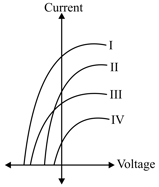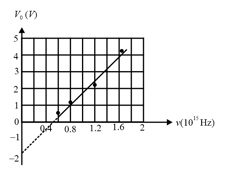MEDIUM
Earn 100
In a photoelectric experiment 3 different lights are incident on a metal of work function . Light is wavelength with intensity , light is with and light is with . The current versus voltage is measured. Which graphs correspond to which light?


(a)Light A-I, Light B-III, Light C-II
(b)Light A-I, Light B-II, Light C-IV
(c)Light A-I, Light B-III, Light C-IV
(d)Light A-III, Light B-II, Light C-IV
50% studentsanswered this correctly
Important Questions on Dual Nature of Radiation and Matter
MEDIUM
Light of wavelength is incident on a metal with work function . The de Broglie wavelength of the emitted electron is:
HARD
In a historical experiment to determine Planck's constant, a metal surface was irradiated with light of different wavelengths. The emitted photoelectron energies were measured by applying a stopping potential. The relevant data for the wavelength of incident light and the corresponding stopping potential are given below:
| 0.3 | 2.0 |
| 0.4 | 1.0 |
| 0.5 | 0.4 |
Given that Planck's constant (in units of ) found from such an experiment is :
MEDIUM
Photons with energy of are incident on a cathode, in a photoelectric cell. The maximum energy of emitted photoelectrons is When photons of energy are incident on , no photoelectrons will reach the anode, , if, the stopping potential of relative to is
HARD
In a photoelectric experiment, a parallel beam of monochromatic light with the power of is incident on a perfectly absorbing cathode of work function . The frequency of light is just above the threshold frequency so that the photoelectrons are emitted with negligible kinetic energy. Assume that the photoelectron emission efficiency is 100%. A potential difference of is applied between the cathode and the anode. All the emitted electrons are incident normally on the anode and are absorbed. The anode experiences a force due to the impact of the electrons. The value of is __________. Mass of the electron .
MEDIUM
The anode voltage of a photocell is kept fixed. The wavelength of the light falling on the cathode is gradually changed. The plate current of the photocell varies as follows :
MEDIUM
The continuous part of -ray spectrum is a result of the
MEDIUM
When a certain metallic surface is illuminated with monochromatic light of wavelength the stopping potential for photoelectric current is and when the same surface is illuminated with light of wavelength the stopping potential is The threshold wavelength of this surface for photoelectric effect is
MEDIUM
The maximum velocity of the photoelectrons emitted from the surface is when light of frequency falls on a metal surface. If the incident frequency is increased to , the maximum velocity of the ejected photoelectrons will be:
HARD
A metal plate of area is illuminated by a radiation of intensity . The work function of the metal is The energy of the incident photons is and only of it produces photo electrons. The number of emitted photo electron per second and their maximum energy, respectively, will be:
HARD
The radiation corresponding to transition of hydrogen atom falls on a metal surface to produce photoelectrons. These electrons are made to enter a magnetic field of . If the radius of the largest circular path followed by these electrons is 10.0 mm, the work function of the metal is close to :
MEDIUM
Photons of wavelength are incident on a metal. The most energetic electrons ejected from the metal are bent into a circular are of radius R by a perpendicular magnetic field having a magnitude B. The work function of the metal is (Where symbols have their usual meanings).
EASY
When a certain photosensitive surface is illuminated with a monochromatic light of frequency the stopping potential of the photo current is When the surface is illuminated by monochromatic light of frequency the stopping potential is The threshold frequency for photoelectric emission is
MEDIUM
On a photosensitive material, when the frequency of incident radiation is increased by , the kinetic energy of emitted photoelectrons increases from to . The work function of the surface is
MEDIUM
When a metallic surface is illuminated with radiation of wavelength , the stopping potential is . If the same surface is illuminated with radiation of wavelength , the stopping potential is . The threshold wavelength for the metallic surface is:
EASY
The electric field of certain radiation is given by the equation falls in a metal surface having work function The maximum kinetic energy of the photoelectrons is [Planck's constant and electron charge ]
MEDIUM
In a photocell circuit, the stopping potential, is a measure of the maximum kinetic energy of the photoelectrons. The following graph shows experimentally measured values of stopping potential versus frequency, of incident light.

The values of Planck's constant and the work function as determined from the graph are (taking the magnitude of electronic charge to be,),
MEDIUM
A laser light of wavelength is used to weld Retina detachment. If a laser pulse of width and power is used, the approximate number of photons in the pulse are (Take Planck's Constant,
EASY
Maximum kinetic energy of a photoelectric varies with the frequency of the incident radiation as
EASY
A photoelectric surface is illuminated successively by monochromatic light of wavelength and . If the maximum kinetic energy of the emitted photoelectrons in the second case is 3 times that in the first case, the work function of the surface of the material is:
( = Planck's constant, = speed of light)
HARD
The magnetic field associated with a light wave is given, at the origin, by If this light falls on a silver plate having a work function of what will be the maximum kinetic energy of the photoelectrons?

